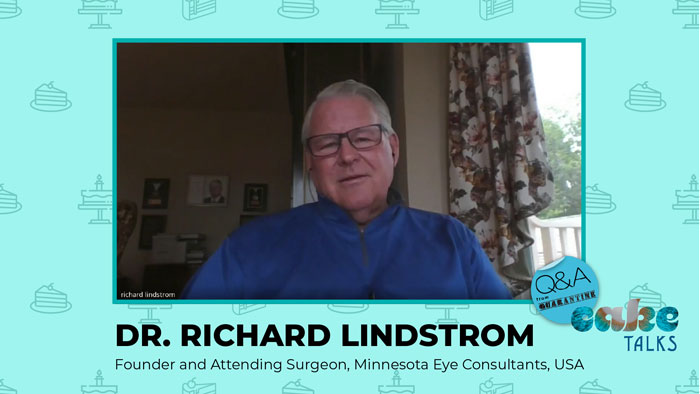Dr. Richard Lindstrom is a true industry veteran — someone who speaks from a wealth of authority and experience. With 40+ years in the industry, dozens of patents, his own practice, and more, he’s the sort of ophthalmologist who can see the big picture.
That big picture of current ophthalmic affairs is what he and CAKE magazine CEO Matt Young discussed in their recent talk, as well as some more general life advice for young and aspiring ophthalmologists. So, let’s start where most stories start: at the beginning.
Recovering from the Downturn
Of course, no discussion of the current state of ophthalmology would be complete without covering the industry’s anticipated recovery from the virus that shall not be named. The good news is that the worst of the downturn seems to be over — the dark days of April and early May are lifting and practices are re-opening and serving patients again. In Minnesota, Dr. Lindstrom’s home state, surgeons could practice routine care and elective surgery again as of May 18th.
As Dr. Lindstrom put it, polls have shown that blindness is one of the scariest things imaginable to most Americans (and, one could extrapolate, most people worldwide). So, patients are certainly motivated to come in for treatment, especially if they have conditions like age-related macular degeneration (AMD) or glaucoma that require management. Dr. Lindstrom predicts a mini-boom throughout the summer as patients return for treatment and noted that some practices are electing to stay open through the evening and into the weekend — and that patients don’t seem to mind.
Of course, there are hurdles to be jumped: Doctors won’t be able to see the same number of patients as before since examination rooms and surgical equipment need to be thoroughly cleaned to prevent infection. Whereas he could see six or seven patients an hour before, he said, he’s being scheduled for four now. This makes for less efficiency in practice, but still gets patients in the door.
Playing Catch-Up
Of course, with many surgeries postponed due to the coronavirus, there is a significant backlog of treatments. Just how big? Dr. Lindstrom explained that there are roughly 4 million cases of cataracts per year in the United States, and around 10-20% of those were missed due to the lockdown. The result? A six to eight hundred thousand backlog of cataract cases that need to be caught up on. Dr. Lindstrom said that cataract patients are coming back quickly.
In the meantime, refractive and elective surgeries may take a back seat. Dr. Lindstrom indicated that his organization was de-emphasizing refractive surgery, including treatments like LASIK, and that these treatments would likely pick up again later.
One advantage ophthalmologists have is that they’re not always tied to hospitals. Many patients are afraid to undergo surgery in hospitals for obvious reasons, and being separate from hospitals is alluring to patients who are reasonably cautious.
Refractive surgeries have dropped considerably for years from a peak of 1.4 million surgeries per year down to 500,000 — a 70% drop. Dr. Lindstrom had an interesting take on why — millennials are the new demographic for the surgeries, and many millennials are underemployed and in debt. So, while they still have to shell out money for contact lenses or glasses, they may not be willing to part with the extra cash for refractive treatments. Still, Dr. Lindstrom noted, around 3 million Americans per year stop using contact lenses.
Business Talk
Ophthalmic practices are businesses, and all businesses face the same principles: Earn money or go under. In that regard, nothing has changed — managing factors like revenue per hour are still key to making the business function, even in the face of severe hurdles.
With fewer patients to see per hour — both due to lower demand and to stricter safety requirements — there may be a bit of a squeeze. Overhead is hard to drop: The same amount of staff is still necessary, for example, as well as the same amount of infrastructure like building space and equipment.
As Dr. Lindstrom advised practices, “Stay solvent and make sure you look carefully at your cash flow because it is going to be somewhat reduced. Now is not the time to go out and make a major purchase. I think that’s also going to impact the industry a little bit and that many of us probably won’t be buying the next instrument or the next diagnostic device right away here in the next six or twelve months. Most of us are going to be pretty careful about capital expenditures.” He added, “There’ll be a little bit of a leg for industry as well I believe.”
Still, the industry is resilient and has shown remarkable adaptivity in the past. “In my lifetime we’ve gone from 1 cataract every 2 hours to a minimum of 4 cataracts per hour,” said Dr. Lindstrom.
He foresees a strong possibility that a meaningful number of ophthalmologists will retire, taking the pandemic as their cue to leave the industry behind. This may lead to a bit of change for the industry: As it is somewhat senior-heavy, this change may lead to a bit of a squeeze: A 10% drop in the number of ophthalmologists could make others in the industry very busy, as he put it. It could also lead to the absorption of smaller practices by larger practices — something that is hardly new, however.
Making It Big
With his wealth of experience, Dr. Lindstrom is specially suited to offering advice to young and aspiring ophthalmologists. So, how does one go from an entry-level ophthalmologist to a world-renowned one?
Dr. Lindstrom sees two steps to start. “The first thing is to get super well trained. I had a quality training residency. I did two years of fellowship which was pretty unusual back in that day so I got myself very well trained. The second thing is if you have something you’re passionate about then the goal is to build a meaningful clinical practice. So, the first step is to get good at and really busy with those things you may be passionate about.”
To break into industry and bigger roles? It requires a similar level of devotion and passion. “The way you get engaged is get really busy and good at something and then get involved in the clinical trials and then teach college. You know how to do it… and it can go from being local to regional, to national to global.”



